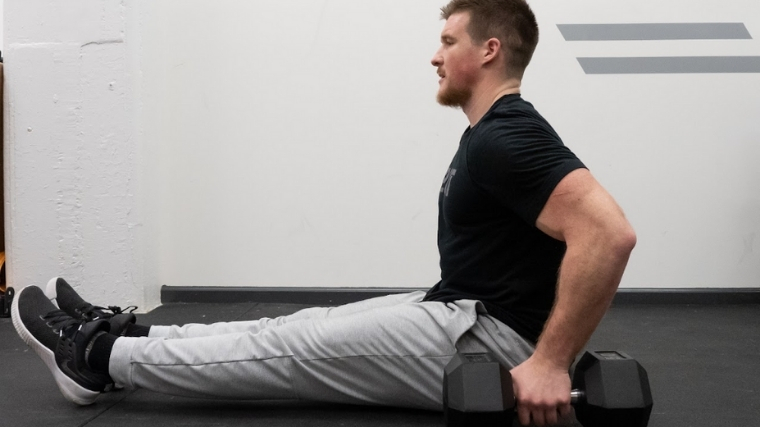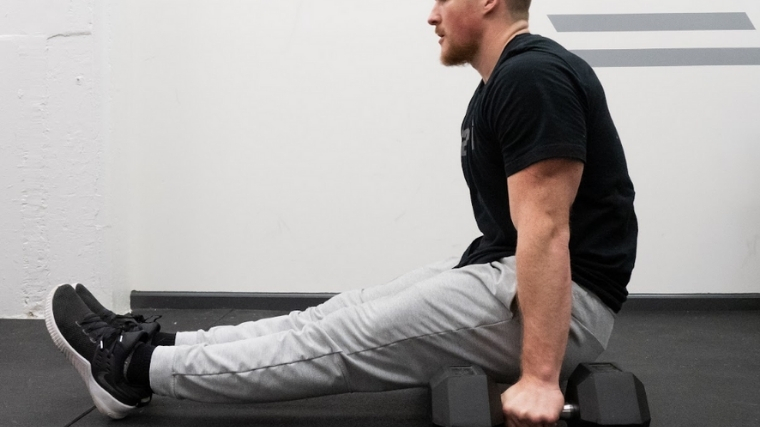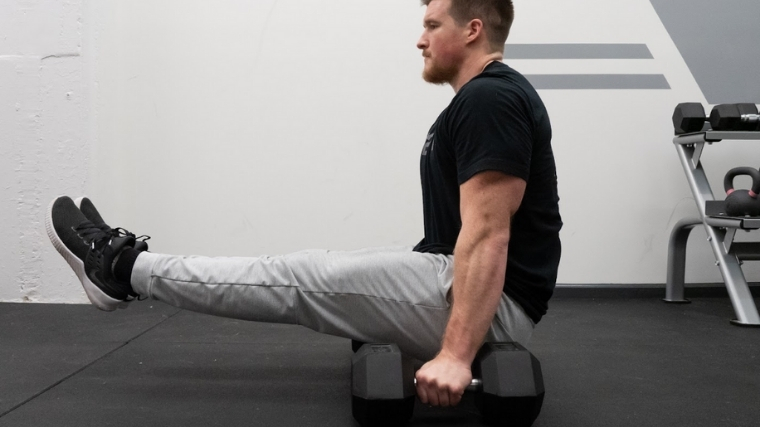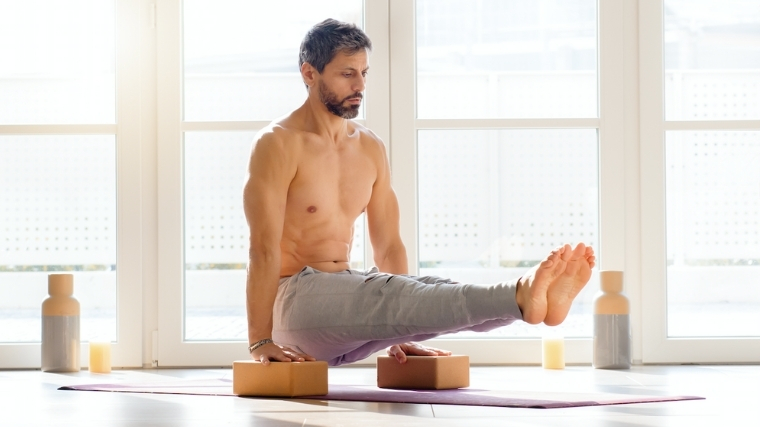Anytime you walk into a gym, there’s a good chance that you’ll see someone performing a plank. Chances are you’ve done one too. Maybe you’re getting bored with the same core exercises, so if you’re looking for a different way to build core strength and stability, the L-sit is it. A movement that not only targets your abs but other muscles like your quadriceps, triceps, and hip flexors, the L-sit is a challenging but beneficial exercise.
If you’re wondering how gymnasts like Jaime Da Silva get so ripped without lifting weights, it’s bodyweight exercises like the L-sit that contribute to that physique. Even if getting washboard abs isn’t your goal, a strong core is crucial for weightlifting and protecting your spine. The L-sit is a functional movement that, when practiced properly, can help improve your overall athletic performance and daily life.
- How to Do the L-Sit
- Benefits of the L-Sit
- Muscles Worked By the L-Sit
- Who Should Do the L-Sit
- How to Program the L-Sit
- L-Sit Alternatives
- L-Sit Variations
- Frequently Asked Questions
Editor’s note: The content on BarBend is meant to be informative in nature, but it shouldn’t take the place of advice and/or supervision from a medical professional. The opinions and articles on this site are not intended for use as diagnosis, prevention, and/or treatment of health problems. Speak with your physician if you have any concerns.
How to Do the L-sit
Below is a step-by-step guide on how to perform the L-sit. This guide covers the standard L-sit on parallel bars and the more advanced L-sit from the floor.
Step 1 — Get Set

Set two parallel bars, boxes, parallettes or a pair of dumbbells (as shown) about shoulder-width apart. Stand between them with your palms on either side in line with your shoulders.
Form Tip: If you don’t have access to any of this equipment, you can perform seated with your hands flat on the floor and legs already extended in front of you. This is a more challenging option because it requires more control and stability, but it’s a great option if you’re already familiar with the move.
Step 2 — Push Down and Lift Off

Firmly push down through the bars or box while lifting your body off the floor. Straighten your arms and lock your elbows out. Pull your shoulders down away from your ears.
Form Tip: Keep your core engaged and your back straight up. This will help protect your back and prevent injury. Look straight ahead to keep your spine in neutral.
Step 3 — Raise Your Legs and Hold

Once you’re in a stable position, engage your core and squeeze your legs together. Start to slowly lift your legs in front of you, creating an “L” shape with your body. Hold this position, squeezing your legs and core and pointing your toes.
Form Tip: Perfecting the L-sit takes time and practice, so try to hold it for five to 10 seconds at a time, building up to longer durations.
Benefits of the L-sit
To safely build abdominal muscles, especially as a beginner, any variation of the L-sit is a great way to train to avoid twisting of the spine. Ultimately, stronger abdominal muscles will provide more spine stability.
Build Abdominal Muscles
Even if a six-pack isn’t what you’re looking for, core stability is essential when performing common exercises, such as the deadlift, front squat, push-ups, and more. It’s important to understand that your core is not just one muscle. It comprises several different muscles that, when practiced, help improve posture, allow you to lift heavier weights, and protect your spine from unwanted twisting.
Increased Shoulder Strength
While the abs are the main target during the L-sit, the shoulders accrue plenty of work, too. This exercise requires you first to lift your own body weight and hold it. Your arms act as the support system, and so the shoulders, which connect your arms to the torso, are under an immense amount of pressure as they stabilize the body during an L-sit. As a result, you will be able to build shoulder strength and stability. The more stability you have, the less chance of injury when exercising or performing daily tasks.
Increase Overall Strength and Power
By practicing stabilizer exercises such as the L-sit, you can improve your overall gym performance. Explosive movements like running, rowing, clean and jerks, and snatches benefit from a strong core. A strong core helps take the load off the spine and provides a brace to lift heavier weight and prevent back injuries. It also helps to shift effort from the upper body to the lower body and vice versa. The L-sit can be used as an accessory exercise for movements like the squat and deadlift or perform a few sets and turn them into a workout.
Muscles Worked By the L-sit
It may not look like it, but the L-sit is a full-body movement. It won’t take long to feel the burn when performing this exercise. The great thing about the L-sit is not only is it used to build strength and stability in your core, but it builds up your quads, hip flexors, triceps, and shoulders.
Rectus Abdominis
Also known as the abdominal muscles, the rectus abdominis protects the spine and allows for movement. They are parallel muscles that run from the sternum to the pelvis and are separated by the midline. You can see these muscles in those with low body fat, creating what we most know it for as the “six-pack.”
Hip Flexors
Hip flexors are made up of a group of muscles located in your pelvic area. These muscles facilitate simple tasks such as walk, run, and kick. Working out your hip flexors helps create stability in the pelvis and spine and prevents injuries by increasing your range of motion.
Quadriceps Femoris
One of the largest muscles in your body is located in your thigh, the quadriceps femoris, better known as quads. The quads are made up of four muscles and are responsible for improving knee stability and helping you walk, run, stand, and jump. When exercised regularly, these muscles can improve your deadlift, lunge, and squat.
Triceps Brachii
Located on the back of your arm is the triceps brachii. These muscles are responsible for elbow extension and are important for upper body strength. Building your triceps also helps create stability in your shoulders and elbows and increases your general range of motion.
[Read More: The Best Upper Body Exercises and Workouts]
Despite popular belief, if you’re looking to improve your performance and build your arms, it’s the triceps (not so much the biceps) that you want to focus on.
Scapular Stabilizers
Consisting of several different muscles, the scapular stabilizers’ main function is to provide strength, movement, and stability to your shoulder joint. Injuries can occur here when the strength is lacking in these muscles. The scapular stabilizers are important for any overhead movement, such as a ground to an overhead or a push jerk. They also contribute to good posture when exercised regularly.
Pectorals
Pectorals, or pecs, are made up of three muscles located on your chest on either side of your sternum. These muscles are responsible for forward arm rotation, movement, and flexion. Something as simple as pressing yourself off the floor activates your pectorals. When exercising, we use them for moves like the bench press, chest fly, and push-ups. Overall, these muscles contribute to upper body strength and can improve posture when exercised and stretched.
Latissimus Dorsi
The largest muscle in your upper body, the latissimus dorsi, is in your middle and lower back. If you’ve ever done a pull-up, this muscle is a large contributor to that move. Some of its primary functions are to help move and rotate the shoulder and provide back strength and spine stability.
Who Should Do the L-sit
Below are some reasons how CrossFit athletes, gymnasts, and weightlifters can benefit from the L-sit.
CrossFit Athletes
We know by now that core strength and stability are crucial for weight-bearing exercises, but it’s also important for gymnastic-type moves you see in any CrossFit gym, such as toes-to-bar and handstand push-ups.
It’s also not unusual to see the L-sit (or a similar variation) in a CrossFit competition. So, better to be prepared than not.
Gymnasts
The L-sit might just be a perfect exercise for gymnasts as it requires little to no equipment and relies on your own body weight. It is great for building strength for popular gymnastic routines, like bar skills, ring work, handstands.
Olympic Weightlifters
A stronger core means more spine stability, and these two components are essential for lifting a heavy barbell. If you’re lifting the barbell overhead, the shoulder strength and stability earned by the L-sit will help prevent injuries.
The same reasoning above applies to any strength athlete. Powerlifters and strongmen need to brace during heavy lifts for support. A stronger core can help with that bracing, and the L-sit is a prime tool for this purpose.
L-Sit Sets, Reps, and Programming Recommendations
The L-sit is difficult for anyone to conquer, but like with anything, the more you practice, the better you will be. Take options as needed to build up to a full L-sit. Below are training recommendations depending on your goals. Remember, these are only suggestions, and you may need to adjust depending on your ability.
For More Endurance
Accumulate as much time as possible in the L-sit to build endurance. Make sure to maintain good form to get the most out of the exercise.

[Read More: The Best Bodyweight Exercises, + Workouts and Tips From a CPT]
Start with short five-second intervals and increase the hold time as you get stronger. If you cannot reach five seconds in an L-sit, consider performing a modified version. Once you eventually build up to 30-second holds, you should see a positive difference in your normal exercise routine.
To Improve Strength and Technique
To build the strength to hold an L-sit, you must practice proper technique. Commit to practicing L-sit progressions three times per week.
Warm-up by sitting on the ground with your legs extended and palms on the ground. Keep your feet on the ground and press your palms into the ground, straightening your arms and locking your elbows out. Complete three sets of five reps, taking a 10-20 second rest in between. After this, complete the same set and rep count but bring one foot off the ground. Do this for both sides.
L-Sit Variations
You’ve been doing the L-sit the same way all week and want some variety. Luckily, there are many ways to get that full body work in while still keeping things interesting. Below are some different ways to perform the L-sit that require little to no equipment.
L-sit Hang
If you happen to have a pull-up bar or really anything that can hold your body weight, the L-sit hang is a good place to start. It requires core and shoulder strength, but instead of lifting your body off the ground, you hold your body weight up. Don’t forget to pull your shoulders down and away from your ears to engage your lats. If this is still too difficult, try tucking your knees instead of extending your legs.
Floor L-sit
If you’re looking for a more challenging variation of the L-sit, this is definitely it. This is a more difficult position because the tension is greater. You are only supported by your hands instead of bars or boxes, requiring more core and shoulder stability. With your palms on the floor, press up and lockout your elbows. Raise your butt off the floor first, then raise your legs.
Single-Leg L-sit
The single-leg L-sit is a great progression from the tuck L-sit because it still provides more support than a standard L-sit but does require more core strength and stability. To perform, set up like a standard L-sit and tuck one knee to your chest with the other leg extended out in front of you. As a drill, switch your legs back and forth.
L-sit Pull-Up
So you’ve mastered the L-sit, and now you’re looking for a different challenge. While holding the L-sit, hang on a pull-up bar, pull your chest up to the bar, and control as you lower back down.
L-Sit Alternatives
You may not be totally ready for a full L-sit yet because it takes time and practice. Whether you’re building up to your first L-sit, coming off an injury, or postpartum, these alternatives can help build up that core strength and stability needed.
Turkish Get-Up
The Turkish Get-Up is a multi-stp movement that, unlike the L-sit, challenges your core while in motion. To successfully perform the movement, you need to stay stable. It is very challenging, and so it’s suggested you start with no weight before slowly increasing the load you use.
Plank
The plank is a great, universal alternative as it engages your core, shoulders, triceps, quads, and lats. Most people can hold a plank for longer than an L-sit, so it can be used to build up the core strength for an L-sit. On the floor, stack your hands underneath your shoulders and keep your back flat. Be sure not to lift your butt in the air, as that eliminates core engagement.
Tuck L-sit
Maybe you’re a beginner and need a less intense option to improve your L-sit. The tuck L-sit is a great place to start because it engages the same muscles used for an L-sit but requires less core strength. Set up like a standard L-sit for this movement, but instead of extending your legs in front of you, tuck your knees to your chest.
Leg Raise
Lie on your back and press your low back into the floor to engage your core. Squeeze your legs and keep them straight as you lift them off the floor, pointing your toes toward the ceiling. Once at 90 degrees, slowly lower your legs back to the floor. For an extra challenge, keep your feet off the floor when you reset.
FAQs
Will I get abs by performing the L-sit?
Although the L-sit does work the abdominal muscles, it is a full-body exercise that engages the quads, hip flexors, shoulders, triceps, and lats. The L-sit is an effective exercise for building abs and can be safer than other core moves that involve too much twisting or flexion. It’s important to remember that abs are built in the kitchen, so when maintaining a healthy, balanced diet, you’ll start to see those muscles pop out.
Is the L-sit safe for beginners?
Since the L-sit is a more challenging move, novice exercisers will benefit from starting with a progression movement such as the tuck sit or seated leg lifts. If the strength and stability are not there yet, you are more prone to injury, so starting with a less intense option is safer.
How do I get better at the L-sit?
To get better at anything, you need to practice. Commit to it and understand that it won’t happen overnight. Don’t be afraid to modify the L-sit to your ability to strengthen the muscles necessary for a full L-sit.
References
- Baldwin, Kenneth M., Brooks, A. George, Fahey, Thomas D., White, Timothy P. (2000). Exercise Physiology: Human Bioenergetics and Its Applications. Mayfield Publishing Company.
- Baechle, Thomas R., Earle, Roger W. (2008). Essentials of Strength Training and Conditioning. National Strength and Conditioning Association.
- Casey, Patrick R., Childs, John D., & Feldtmann, Angela W. (2010). Effects of Traditional Sit-up Training Versus Core Stabilization Exercises on Short-Term Musculoskeletal Injuries in US Army Soldiers: A Cluster Randomized Trial. Volume 90 (Issue 10). Pages 1404-1412. https://doi.org/10.2522/ptj.20090389
Featured image: Photology1971/Shutterstock